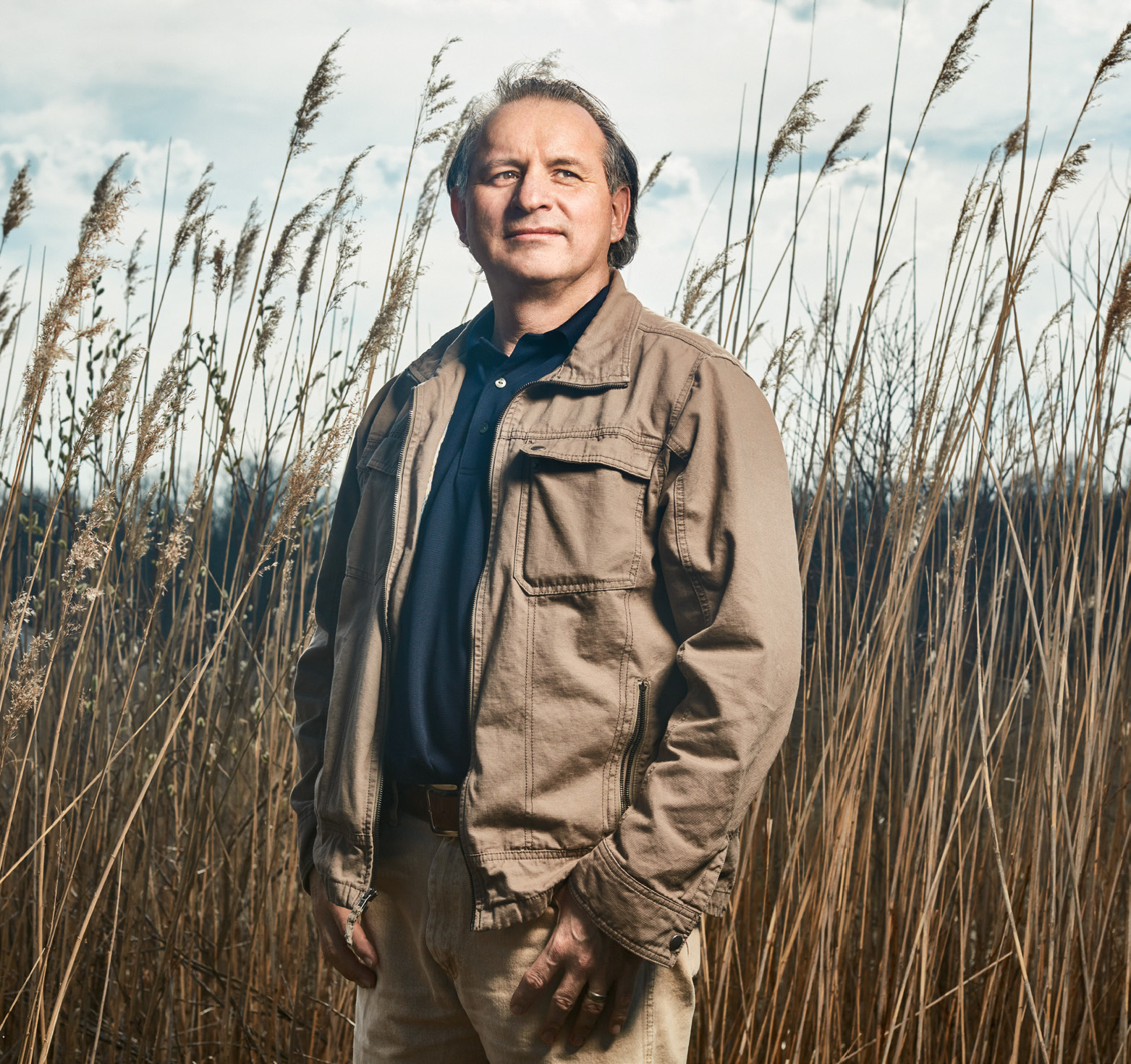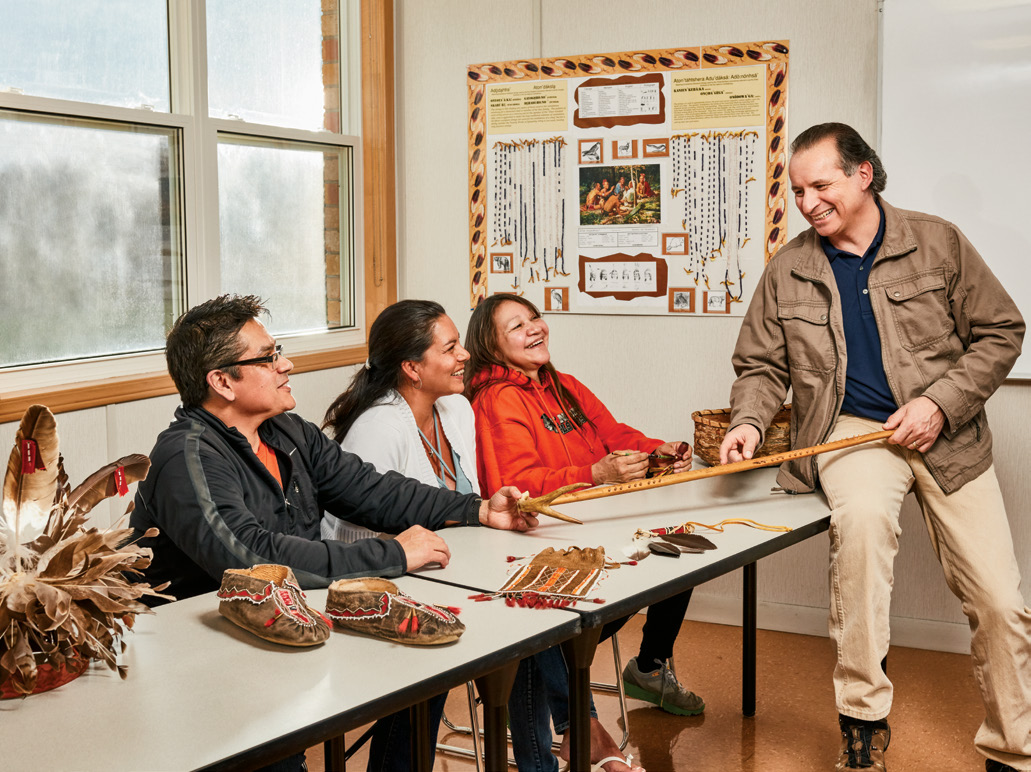Share this page

Tom Deer, OCT, keeps Indigenous culture alive by sharing his lifelong passion for languages with the next generation.
By Jessica Leeder
Photos: Markian Lozowchuk
To view our Great Teaching video archive, visit oct-oeeo.ca/GTvideos
Growing up on the Kahnawake Mohawk reserve in Québec, there was one thing Tom Deer, OCT, the son of a teacher, particularly hated — and that was going to school.
What he loved, though, was languages and learning to speak them. Spurred by the desire to communicate with the Mohawk-speaking grandfather he idolized, the boy seized every opportunity to increase his fluency; it just so happened that most arose outside the classroom.
“I grew up in a language-rich environment,” says Deer. “My parents, as well as my aunts and uncles, all spoke Mohawk. When we would visit, they would switch to Mohawk — I felt left out, always wanting to be a part of that.”
Determined to learn the Iroquoian language, Deer spent much of his adolescence practising it with anyone who would converse with him, mainly with family — coincidentally, many of whom were teachers. Eventually, Deer joined the profession as a Mohawk teacher, passing the endangered language onto the next generation of learners.
With a career spanning more than 30 years, Deer has taught at various schools on Six Nations of the Grand River — the First Nations reserve with the largest population in Canada, located 25 kilometres southwest of Hamilton. His dedication to the profession and preserving his culture has not gone unnoticed. Deer was recently named an outstanding educator of Indigenous students and awarded a 2016 Guiding the Journey: Indigenous Educator Award for his innovative teaching of language, culture and traditions. Colleagues rank Deer among the community’s most important and beloved educators.

“The teachers see him as a role model,” says Reva Bomberry, OCT, principal of I. L. Thomas Odadrihonyanita Elementary, the Cayuga immersion school where Deer works. “His fluency level, his knowledge and his experience in education form an invaluable force and resource. He is a go-to person for leadership around language acquisition, not only for teachers but the broader community as well.”
The irony of being honoured for his work in the classroom — the place he most reviled in his youth — is more acute than ever for Deer, who chuckles at the memory of his young self during a coffee break in the midst of a recent Saturday morning class. “Of course I ended up being a teacher,” he laughs. “But I ended up teaching something that I love, which is language. It has always been my passion.”
Feeding that passion has propelled Deer through a colourful career, during which he has taught language immersion to every grade spanning from kindergarten to Grade 8. He has also instructed fellow teachers, through a language resource position. His work in post-secondary has focused on language courses at McMaster University in Hamilton and, most recently, at Six Nations Polytechnic (SNP) in Ohsweken, Ont., which this year began to offer an accredited bachelor of arts degree in Ogwehoweh Languages (Mohawk or Cayuga). Before working in post-secondary, he had been heavily involved in developing curriculum guidelines for both languages as well as lesson plans, resource materials and translations from traditional manuscripts written by elders.
Although Deer remains on staff at I. L. Thomas, the award winner has spent the last two years on an approved leave, to help co-ordinate SNP’s BA program. He still teaches evening and weekend classes at SNP — many of which are full of teachers working to increase their own fluency.
His tireless efforts to both teach and assist in bolstering Indigenous languages stems from Deer’s worry that their future is endangered. “We are at the point where these languages are having their last gasp and we’re trying to stop that, to bring them back,” Deer says. “We’re not just language teachers. We’re language first responders. There is a lot that needs to be done.”
Unlike most immersion languages taught in provincial schools, Indigenous languages have primarily oral histories. Written texts and teaching tools have always been scarce. “There weren’t any textbooks available — it was all human resources. You had to go and talk to people,” Deer says of when he started out. He would occasionally borrow from his mother who taught Mohawk back in Kahnawake, where they had a resource development program. Today, there is still a dearth of printed materials, a fact that makes tasks such as clarifying correct grammar particularly challenging. It also jeopardizes the future of the language. At I. L. Thomas, where there is a full immersion program up to Grade 4, the aim is to teach every subject in Cayuga. From Grades 5 through 8, students spend one day learning in English and the next in Cayuga. But the balance can be daunting for teachers, many of whom are second-language learners and still working to comprehend the nuances of the language themselves.
“Whatever we teach in the classroom needs to be translated first. This has always been a major gap in our program,” Bomberry says, adding: “We are in such a crisis state.”
As part of his personal effort to reverse this, Deer spearheaded the Speak Cayuga initiative, a language-learning app (iTunes, oct-oeeo.ca/speakcayuga; Google Play, oct-oeeo.ca/cayuga) produced by SNP and Thornton Media, Inc. The free app is designed for users aged four and up; it has over 500 words and phrases, a searchable database, audio, video and images. Launching the app was a proud moment for Deer, who is a proponent of using a broad spectrum of technology in the classroom — from high-tech smartphone apps to none at all.
"We’re not just language teachers. We’re language first responders. There is a lot that needs to be done."
“The world of technology is great,” Deer explains. “But it is also important to go back to the basics.” A useful teaching tool of his is an empty shoebox, which he fills up with household gadgets and trinkets before bringing it to class. Sitting in a circle, students of all ages can pass the box, take out an item and discuss it using whatever language they’re trying to learn. The technique has stood the test of time for all ages.
“You have to stop and make time for those sorts of things,” Deer explains. “Because sometimes they turn out to be the best. You have to use the language as much as you can in all aspects of your life.” As far as he’s concerned, the more avenues students have to learn, the better.
“When I was learning, I had to stumble through and get people to help me understand the grammar of a language that wasn’t written. That wasn’t always easy and some people weren’t always nice [about it],” Deer says.
With both children and adults, Deer’s approach is intentionally gentle and non-threatening. For his students and colleagues alike, that manner is key to helping them learn effectively.
“Our elementary schools were a horrible atmosphere to grow up in. There was a lot of trauma if you spoke your [Indigenous] language and there is a whole generation of us who were shamed,” says Coleen Powless, OCT, a teacher at I. L. Thomas and a student in Deer’s SNP Saturday morning class and Monday evening governance class (taught in Mohawk and Cayuga). “Tom is not just a teacher. He’s a leader for our people,” she says, “Our whole community depends on him and he carries that graciously.”
Bomberry insists that the pride Deer instils in students by championing Indigenous languages not only fosters education but is healing their community.
“There’s just an honour that he brings to speaking the language,” she says. “Overcoming the shame has been a major obstacle. Today’s generation of language learners are still affected by the past — residential schools have beaten the language out of our people — but are now beginning to embrace our language and culture. Tom’s eloquent speaking and teaching lends us that ability.”
Understanding the breadth of the impact he is having both in and outside of the classroom motivates Deer in his educational journey, which he says will likely continue for at least another decade.
“To be part of a process that makes people proud of their language, and who they are, rather than believing they should be covered up and forgotten,” he says, “that has been rewarding.”
The OCT featured in this profile has been recognized with a national teaching award and exemplifies the high standards of practice to which the College holds the teaching profession.
All language teachers know the challenges of keeping English out of the classroom when immersion is the intention. Here are Deer’s top tips for success: